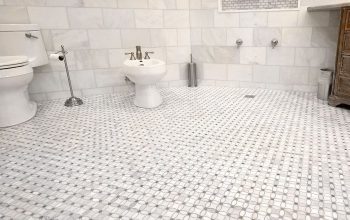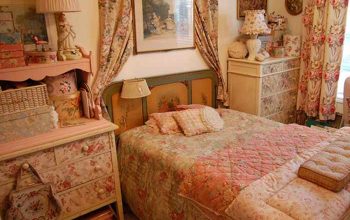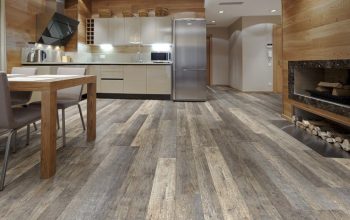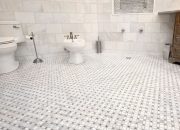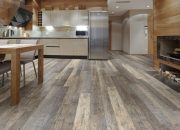Space-Saving Design Strategies for Half Baths: Half Bath Decor Ideas

Half bath decor ideas – Right, so you’ve got a half-bath, a.k.a. a bog, that’s smaller than a postage stamp? Don’t panic, mate. With a bit of savvy planning, even the tiniest loo can be transformed into a stylish and functional space. We’re talking clever design hacks that’ll make you say “Crikey, I didn’t think that was possible!”
Maximising space in a compact half-bath requires a strategic approach, focusing on clever layouts and storage solutions that don’t compromise on style. Think vertical storage, built-in units, and a bit of minimalist magic. Forget about cramming in unnecessary furniture – less is definitely more in this situation.
Compact Half Bath Layouts
A well-designed layout is the bedrock of any successful small-space project. In a half-bath, the key is to optimise the flow. Consider a corner sink to free up floor space. A wall-mounted toilet, rather than a floor-standing one, creates a more open feel. And, of course, make sure there’s enough room to actually, you know,use* the facilities without feeling claustrophobic.
Think about the placement of the door – a swinging door might eat up precious space, so a sliding door could be a right winner.
Space-Saving Storage Solutions
Storage in a small half-bath is a bit of a game-changer, innit? You need to be cunning about it. Recessed shelving built into the walls is a top tip – it keeps everything tidy and out of sight. Floating shelves above the toilet are another brilliant idea, perfect for storing toiletries or extra toilet rolls. A vanity unit with drawers rather than cupboards maximises vertical space and keeps things organised.
Under-sink storage, if you’ve got the space, can be a lifesaver too, and don’t forget about those nifty over-the-door organisers for extra storage capacity.
Utilising Vertical Space
Vertical space is your best mate in a small half-bath. Think tall, slender cabinets that reach up to the ceiling. These maximise storage without taking up valuable floor space. Wall-mounted mirrors are not only stylish but also create the illusion of more space. And don’t underestimate the power of tall, narrow shelving units.
These can be used to display decorative items or store towels, all while adding a touch of visual interest.
Example of a Half Bath with Built-in Shelving
Imagine a half-bath with crisp white walls and a dark grey tiled floor. The sink is a sleek, modern design, corner-mounted to save space. A wall-mounted toilet sits neatly beside it. The real star of the show, however, is the built-in shelving. A long, narrow unit stretches from floor to ceiling next to the toilet, featuring a mix of open and closed shelving.
The open shelves display a few carefully chosen decorative items – a small potted plant, a stylish soap dispenser, and a couple of neatly rolled hand towels. The closed shelves, with their sleek white doors, offer ample storage for toiletries and cleaning supplies. The overall effect is one of understated elegance and surprising spaciousness. It’s a bit of a triumph, really.
Material Choices and Their Impact on Half Bath Design

Right, so, let’s get down to the nitty-gritty of half-bath materials. Choosing the right stuff is absolutely crucial, not just for the aesthetics – although, let’s face it, that’s a big part of it – but also for practicality and longevity. We’re talking about a space that’s going to see a fair bit of moisture, so making savvy material choices is key to avoiding a right royal mess down the line.The selection of materials significantly impacts the overall look, feel, and maintenance of a half-bath.
Different materials offer unique advantages and disadvantages concerning durability, aesthetics, and cost-effectiveness. Consider the style you’re aiming for – a sleek modern look, a rustic charm, or something totally different – and how the chosen materials will contribute to that vision.
Tile Advantages and Disadvantages
Ceramic and porcelain tiles are absolute stalwarts in half-baths. They’re ridiculously water-resistant, easy to clean (a massive plus in a high-moisture environment), and come in a gazillion colours and styles. However, they can be a bit chilly underfoot, and if you drop something heavy on them, you might end up with a crack. Also, grouting can be a pain to keep clean, and re-grouting can be a bit of a faff.
Porcelain is generally more durable and less porous than ceramic, making it a top contender for floors.
Stone Advantages and Disadvantages
Natural stone, like marble or slate, brings a touch of luxury. It’s undeniably gorgeous, but it’s also more expensive and requires more meticulous care. Marble, for instance, is prone to staining and etching, which requires regular sealing and careful cleaning. Slate, while more durable, can still be susceptible to staining if not properly sealed. The porous nature of some stones means they absorb moisture, potentially leading to issues over time.
It’s a high-maintenance option that demands a bit more TLC.
Wood Advantages and Disadvantages
Wood might seem like a bit of a rogue choice in a half-bath, but with the right treatment, it can work. It adds warmth and character that you just can’t get from tiles or stone. However, it’s absolutely crucial to use wood specifically designed for wet areas – something treated with a water-resistant sealant. Even then, it’s more prone to warping or damage from prolonged exposure to moisture than tiles or stone.
Regular maintenance is essential to keep it looking its best.
Half-Bath Material Selection: A Design Example, Half bath decor ideas
Let’s imagine a half-bath design that prioritises both durability and a chic aesthetic. The floor could be laid with large-format porcelain tiles in a neutral grey, offering a clean, modern look and excellent water resistance. The walls could feature smaller, textured ceramic tiles in a subtle pattern above a wainscoting of durable, water-resistant wood panelling. The countertop could be a sleek quartz surface – a man-made material that mimics the look of natural stone but is far more resistant to staining and damage.
This combination provides a stylish, low-maintenance, and practical half-bath solution.
Materials Suitable for Half-Bath Construction
Before we wrap this up, a quick rundown of suitable materials, categorised by application:
Choosing the right material for each surface is paramount to creating a functional and aesthetically pleasing half-bath. Consider factors like moisture resistance, durability, and ease of maintenance when making your selections.
| Surface | Suitable Materials |
|---|---|
| Walls | Ceramic tile, porcelain tile, glass tile, waterproof paint, wainscoting (water-resistant wood) |
| Floors | Porcelain tile, ceramic tile, natural stone (sealed), vinyl |
| Countertops | Quartz, granite, marble (sealed), solid surface materials |
Frequently Asked Questions
What is the ideal size for a half bath vanity?
The ideal vanity size depends on the space, but generally, a 24-inch wide vanity is the minimum for a comfortable half bath. Larger vanities (30-36 inches) offer more counter space.
How can I make a small half bath feel larger?
Use light colors, large mirrors, and good lighting to create an illusion of more space. Avoid bulky furniture and choose compact fixtures.
What are some low-maintenance materials for a half bath?
Porcelain tile, glass, and sealed natural stone are durable and easy to clean, making them ideal for high-traffic areas like half baths.
How much does a half bath renovation typically cost?
Costs vary widely based on location, materials, and labor. A basic renovation can range from a few hundred to several thousand dollars.

